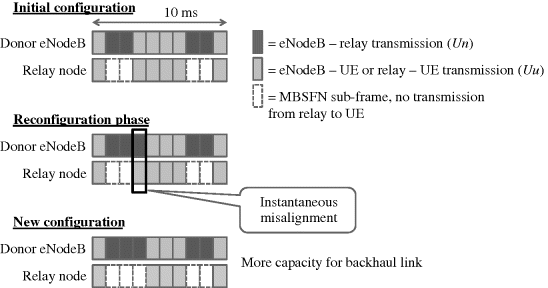9.5 Radio Resource Management
The capacity partitioning between backhaul and access links for in-band relays can be adjusted according to capacity requirements, for example depending on how many relays compete on the backhaul link. For this purpose the set of downlink relay node sub-frames, during which downlink backhaul transmission may occur, can be adjusted. The set of uplink relay node sub-frames, during which uplink backhaul transmission may occur is implicitly derived from the downlink relay node sub-frames using the HARQ timing relationship. The resource allocation for the relay node sub-frames is controlled by the donor eNodeB and RRC signalling is used to inform the relay node about these resources. The relay node sub-frame reconfiguration is activated immediately after its reception by the relay node. The sub-frames for the backhaul and access links can be temporarily misaligned because the new sub-frame configuration can be applied earlier on the backhaul link than on the access link. An example reconfiguration is shown in Figure 9.18. The fourth sub-frame is reconfigured from access link to backhaul link.
Figure 9.18 Reconfiguration of capacity between backhaul and access links.

The eNodeBs in LTE FDD operation do not need to be synchronized in the time domain. The time synchronization is only required for TDD operation, for MBMS transmission and may be needed for the ...
Get LTE Advanced: 3GPP Solution for IMT-Advanced now with the O’Reilly learning platform.
O’Reilly members experience books, live events, courses curated by job role, and more from O’Reilly and nearly 200 top publishers.

